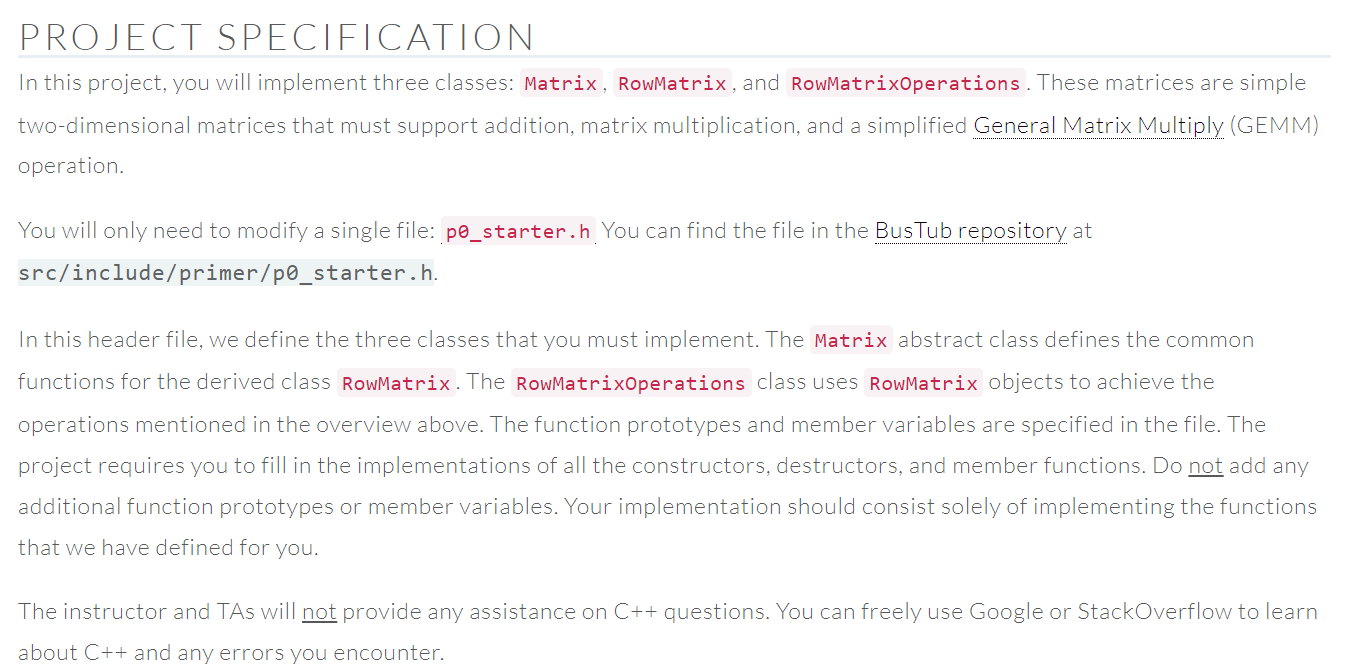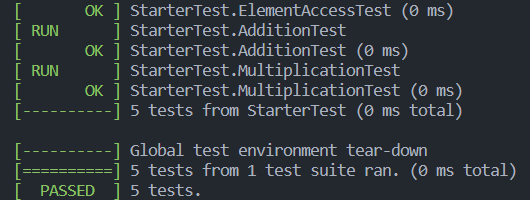这个实验主要用来测试大家对现代 C++ 的掌握程度,实验要求如下:

简单翻译一下上述要求,就是我们需要实现定义在 src/include/primer/p0_starter.h 中的三个类 Matrix、RowMatrix 和 RowMatrixOperations,其中 Matrix 是 RowMatrix 的父类,RowMatrixOperations 定义了三个用于数组运算的成员函数:Add、Multiply 和 GEMM(就是 \(\boldsymbol{A}*\boldsymbol{B} + \boldsymbol{C}\))。
抽象基类 Matrix 需要我们编写的代码很少,只要完成构造函数和析构函数即可,下面省略了一些不需要我们写的代码:
template <typename T>
class Matrix {
protected:
/**
*
* Construct a new Matrix instance.
* @param rows The number of rows
* @param cols The number of columns
*
*/
Matrix(int rows, int cols) : rows_(rows), cols_(cols), linear_(new T[rows * cols]) {}
int rows_;
int cols_;
T *linear_;
public:
/**
* Destroy a matrix instance.
* TODO(P0): Add implementation
*/
virtual ~Matrix() { delete[] linear_; }
};
linear_ 指向一个由二维矩阵展平而得的一维数组,里面共有 rows * cols 个类型为 T 的元素。由于我们在堆上分配数组的空间使用的是 new T[],所以删除的时候也得用 delete[]。
这个类用于表示二维矩阵,需要实现父类 Matrix 中的所有纯虚函数,为了方便访问数据元素,RowMatrix 多定义了一个指针数组 data_,里面的每个元素分别指向了二维矩阵每行首元素的地址:
template <typename T>
class RowMatrix : public Matrix<T> {
public:
/**
* Construct a new RowMatrix instance.
* @param rows The number of rows
* @param cols The number of columns
*/
RowMatrix(int rows, int cols) : Matrix<T>(rows, cols) {
data_ = new T *[rows];
for (int i = 0; i < rows; ++i) {
data_[i] = &this->linear_[i * cols];
}
}
/**
* @return The number of rows in the matrix
*/
auto GetRowCount() const -> int override { return this->rows_; }
/**
* @return The number of columns in the matrix
*/
auto GetColumnCount() const -> int override { return this->cols_; }
/**
* Get the (i,j)th matrix element.
*
* Throw OUT_OF_RANGE if either index is out of range.
*
* @param i The row index
* @param j The column index
* @return The (i,j)th matrix element
* @throws OUT_OF_RANGE if either index is out of range
*/
auto GetElement(int i, int j) const -> T override {
if (i < 0 || i >= GetRowCount() || j < 0 || j >= GetColumnCount()) {
throw Exception(ExceptionType::OUT_OF_RANGE, "The index out of range");
}
return data_[i][j];
}
/**
* Set the (i,j)th matrix element.
*
* Throw OUT_OF_RANGE if either index is out of range.
*
* @param i The row index
* @param j The column index
* @param val The value to insert
* @throws OUT_OF_RANGE if either index is out of range
*/
void SetElement(int i, int j, T val) override {
if (i < 0 || i >= GetRowCount() || j < 0 || j >= GetColumnCount()) {
throw Exception(ExceptionType::OUT_OF_RANGE, "The index out of range");
}
data_[i][j] = val;
}
/**
* Fill the elements of the matrix from `source`.
*
* Throw OUT_OF_RANGE in the event that `source`
* does not contain the required number of elements.
*
* @param source The source container
* @throws OUT_OF_RANGE if `source` is incorrect size
*/
void FillFrom(const std::vector<T> &source) override {
if (static_cast<int>(source.size()) != GetRowCount() * GetColumnCount()) {
throw Exception(ExceptionType::OUT_OF_RANGE, "The number of elements of `source` is different from matrix");
}
for (int i = 0; i < GetRowCount(); ++i) {
for (int j = 0; j < GetColumnCount(); ++j) {
data_[i][j] = source[i * GetColumnCount() + j];
}
}
}
/**
* Destroy a RowMatrix instance.
*/
~RowMatrix() override { delete[] data_; }
private:
T **data_;
};
需要注意的是,在 RowMatrix 中访问基类部分的成员(非虚函数)时需要加上 this 指针,不然编译时会报错说找不到指定的成员。
实现该类的三个成员函数之前应该检查数据维度是否匹配,不匹配就返回空指针,否则开个循环遍历二维矩阵完成相关操作即可:
template <typename T>
class RowMatrixOperations {
public:
/**
* Compute (`matrixA` + `matrixB`) and return the result.
* Return `nullptr` if dimensions mismatch for input matrices.
* @param matrixA Input matrix
* @param matrixB Input matrix
* @return The result of matrix addition
*/
static auto Add(const RowMatrix<T> *matrixA, const RowMatrix<T> *matrixB) -> std::unique_ptr<RowMatrix<T>> {
if (matrixA->GetRowCount() != matrixB->GetRowCount() || matrixA->GetColumnCount() != matrixB->GetColumnCount()) {
return std::unique_ptr<RowMatrix<T>>(nullptr);
}
auto rows = matrixA->GetRowCount();
auto cols = matrixA->GetColumnCount();
auto matrix = std::make_unique<RowMatrix<T>>(rows, cols);
for (int i = 0; i < rows; ++i) {
for (int j = 0; j < cols; ++j) {
matrix->SetElement(i, j, matrixA->GetElement(i, j) + matrixB->GetElement(i, j));
}
}
return matrix;
}
/**
* Compute the matrix multiplication (`matrixA` * `matrixB` and return the result.
* Return `nullptr` if dimensions mismatch for input matrices.
* @param matrixA Input matrix
* @param matrixB Input matrix
* @return The result of matrix multiplication
*/
static auto Multiply(const RowMatrix<T> *matrixA, const RowMatrix<T> *matrixB) -> std::unique_ptr<RowMatrix<T>> {
if (matrixA->GetColumnCount() != matrixB->GetRowCount()) {
return std::unique_ptr<RowMatrix<T>>(nullptr);
}
auto rows = matrixA->GetRowCount();
auto cols = matrixB->GetColumnCount();
auto matrix = std::make_unique<RowMatrix<T>>(rows, cols);
for (int i = 0; i < rows; ++i) {
for (int j = 0; j < cols; ++j) {
T sum = 0;
for (int k = 0; k < matrixA->GetColumnCount(); ++k) {
sum += matrixA->GetElement(i, k) * matrixB->GetElement(k, j);
}
matrix->SetElement(i, j, sum);
}
}
return matrix;
}
/**
* Simplified General Matrix Multiply operation. Compute (`matrixA` * `matrixB` + `matrixC`).
* Return `nullptr` if dimensions mismatch for input matrices.
* @param matrixA Input matrix
* @param matrixB Input matrix
* @param matrixC Input matrix
* @return The result of general matrix multiply
*/
static auto GEMM(const RowMatrix<T> *matrixA, const RowMatrix<T> *matrixB, const RowMatrix<T> *matrixC)
-> std::unique_ptr<RowMatrix<T>> {
if (matrixA->GetColumnCount() != matrixB->GetRowCount()) {
return std::unique_ptr<RowMatrix<T>>(nullptr);
}
if (matrixA->GetRowCount() != matrixC->GetRowCount() || matrixB->GetColumnCount() != matrixC->GetColumnCount()) {
return std::unique_ptr<RowMatrix<T>>(nullptr);
}
return Add(Multiply(matrixA, matrixB).get(), matrixC);
}
};
打开 test/primer/starter_test.cpp,将各个测试用例里面的 DISABLED_ 前缀移除,比如 TEST(StarterTest, DISABLED_SampleTest) 改为 TEST(StarterTest, SampleTest),之后运行下述命令:
mkdir build
cd build
cmake ..
make starter_test
./test/starter_test
测试结果如下图所示:

这次实验感觉比较简单,主要考察虚函数、模板和动态内存(包括智能指针)的知识,就是没搞明白为什么函数都用尾置返回类型,而且 Google 风格也让人很不习惯,缩进居然只有两格,函数居然开头大写。以上~~
